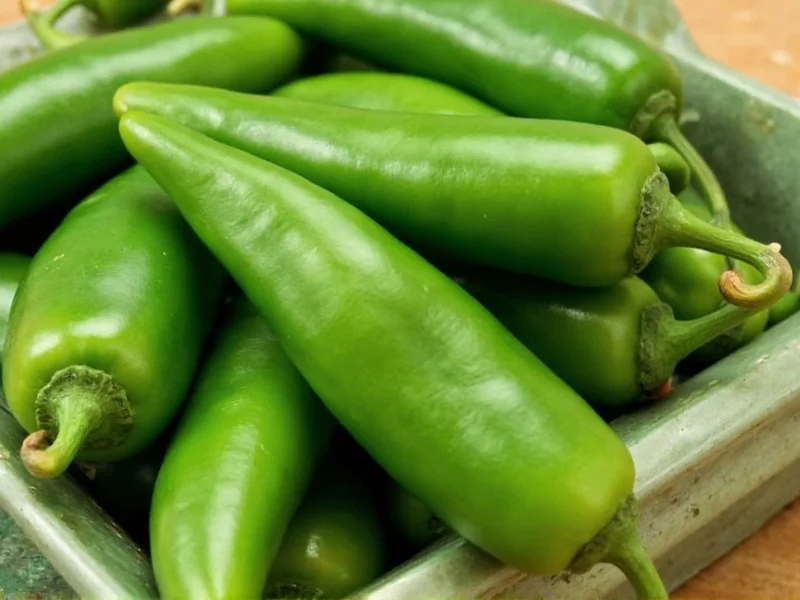Understanding the heat difference between these popular chili peppers is essential for home cooks and culinary enthusiasts. The Scoville scale, which measures capsaicin concentration, provides the scientific basis for comparing pepper heat levels. While both peppers belong to the Capsicum annuum species, their heat profiles differ substantially due to genetic variations and growing conditions.
When planning recipes or substitutions, recognizing the serrano pepper heat level compared to jalapeño is crucial for achieving desired flavor profiles without overwhelming spice. This comprehensive comparison examines not just the numerical heat difference but also practical implications for cooking, flavor profiles, and substitution ratios.
Scoville Scale Explained
The Scoville Organoleptic Test, developed in 1912 by pharmacist Wilbur Scoville, remains the standard measurement for chili pepper heat. The scale quantifies the concentration of capsaicinoids—the compounds responsible for the burning sensation—in Scoville Heat Units (SHU). Modern testing uses high-performance liquid chromatography for more precise measurements, but the Scoville scale remains the common reference.
Direct Heat Comparison: Serrano vs Jalapeño
Understanding how much hotter are serrano peppers than jalapenos requires examining their specific heat ranges:
| Pepper Variety | Scoville Heat Units (SHU) | Relative Heat (Compared to Jalapeño) |
|---|---|---|
| Jalapeño | 2,500-8,000 | 1x (baseline) |
| Serrano | 10,000-23,000 | 2-4x hotter |
| Habanero (for reference) | 100,000-350,000 | 12-40x hotter than jalapeño |
Factors Affecting Pepper Heat
The actual heat level of both serrano and jalapeño peppers can vary significantly based on several factors:
- Growing conditions: Stressors like drought, temperature fluctuations, and soil composition can increase capsaicin production
- Ripeness: Fully ripe red peppers generally contain more capsaicin than green varieties
- Plant genetics: Different cultivars have inherent heat variations
- Part of the pepper: The placenta (white ribs) contains the highest concentration of capsaicin, not the seeds
Practical Cooking Implications
When considering can I substitute serrano for jalapeno in recipes, understanding the heat differential is critical. A direct 1:1 substitution will likely result in an unexpectedly spicy dish. Professional chefs typically recommend:
- Using half the amount of serranos when substituting for jalapeños
- Removing seeds and membranes from serranos to reduce heat
- Adding serranos gradually and tasting as you cook
- Considering the flavor profile—serranos have a brighter, more herbal note compared to jalapeños' earthier taste
Why Are Serrano Peppers Hotter Than Jalapeños?
The heat difference stems from evolutionary adaptations. Serrano peppers originated in the mountainous regions of Mexico's Sierra Madre, where their increased capsaicin production likely served as a defense mechanism against predators. The genetic makeup of serranos produces higher concentrations of dihydrocapsaicin, one of the primary capsaicinoids responsible for heat sensation.
Interestingly, the question why are serrano peppers hotter than jalapenos has a botanical explanation beyond simple heat measurement. Serranos have a thinner wall and higher surface-area-to-volume ratio, which concentrates the capsaicin-producing glands. This structural difference contributes to their more intense heat experience despite belonging to the same species as jalapeños.
Common Misconceptions
Several myths persist about these peppers:
- Myth: The seeds contain most of the heat
Fact: Capsaicin is concentrated in the placenta (white ribs), not the seeds - Myth: Larger peppers are always milder
Fact: Size doesn't correlate directly with heat; growing conditions matter more - Myth: Color determines heat level
Fact: While ripeness affects heat, color alone isn't a reliable indicator
When to Choose Each Pepper
Understanding the serrano vs jalapeno heat comparison helps determine which pepper works best for specific applications:
- Jalapeños are ideal for: Salsas, poppers, pickling, and dishes where moderate heat with earthy flavor is desired
- Serranos excel in: Fresh salsas, hot sauces, and dishes where bright, intense heat is needed without overwhelming smokiness
For those sensitive to spice, jalapeños provide a more approachable heat level, while serranos offer professional chefs a more potent option for complex flavor layering. The serrano pepper Scoville scale rating makes it a versatile middle-ground option between jalapeños and much hotter varieties like habaneros.
Can I substitute serrano peppers for jalapeños in recipes?
Yes, but with caution. Since serranos are 2-4 times hotter than jalapeños, use approximately half the amount of serranos when substituting. For precise control, start with one-quarter the amount and gradually increase to achieve your desired heat level while tasting as you cook.
Why do some jalapeños seem as hot as serranos?
Pepper heat varies significantly based on growing conditions. Stressed plants (from drought, temperature extremes, or poor soil) produce more capsaicin. A particularly hot jalapeño from a stressed plant might approach the lower end of the serrano range (around 8,000-10,000 SHU), creating the impression they're equally hot.
How can I reduce the heat of serrano peppers?
To reduce serrano heat, remove all white ribs and seeds (where capsaicin concentrates), soak sliced peppers in salt water for 15-30 minutes, or cook them longer as heat breaks down capsaicin. Pairing with dairy products like yogurt or sour cream when serving also counteracts the burning sensation.
Do serrano peppers taste different from jalapeños besides being hotter?
Yes, serranos have a brighter, more herbal, and slightly fruitier flavor profile compared to jalapeños' earthier, grassier taste. Serranos also have thinner walls, making them better for fresh applications like pico de gallo, while jalapeños' thicker walls make them ideal for stuffing.
Are there visual differences between serrano and jalapeño peppers?
Yes, serranos are typically smaller (1-2.5 inches), straighter, and smoother with a bright green to red color. Jalapeños are larger (2-3.5 inches), often slightly curved, and have characteristic striations (light-colored stretch marks) as they mature. Serranos grow upright on the plant, while jalapeños hang downward.











 浙公网安备
33010002000092号
浙公网安备
33010002000092号 浙B2-20120091-4
浙B2-20120091-4